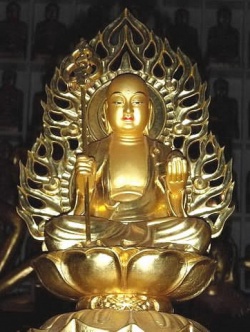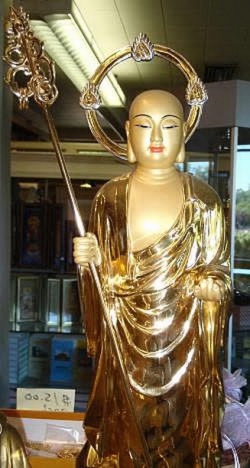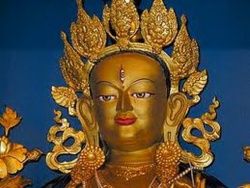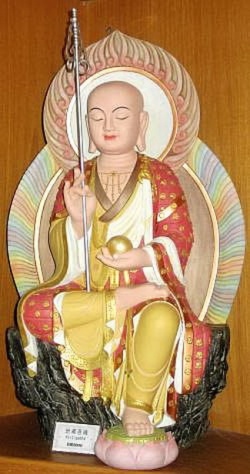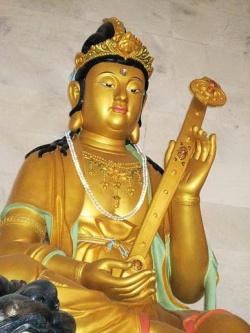Difference between revisions of "Enlightenment in Buddhism"
m (Text replacement - "mediated" to "mediated") |
|||
| Line 107: | Line 107: | ||
A common reference in {{Wiki|western culture}} is the notion of "[[enlightenment]] [[experience]]". This notion can be traced back to {{Wiki|William James}}, who used the term "[[religious]] [[experience]]" in his The Varieties of [[Religious]] [[Experience]]. [[Wayne Proudfoot]] traces the [[roots]] of the notion of "[[religious]] [[experience]]" further back to the {{Wiki|German}} {{Wiki|theologian}} [[Friedrich Schleiermacher]] (1768-1834), who argued that [[religion]] is based on a [[feeling]] of the [[infinite]]. The notion of "[[religious]] [[experience]]" was used by [[Schleiermacher]] to defend [[religion]] against the growing [[scientific]] and {{Wiki|secular}} citique. It was adopted by many [[scholars]] of [[religion]], of which {{Wiki|William James}} was the most influential. | A common reference in {{Wiki|western culture}} is the notion of "[[enlightenment]] [[experience]]". This notion can be traced back to {{Wiki|William James}}, who used the term "[[religious]] [[experience]]" in his The Varieties of [[Religious]] [[Experience]]. [[Wayne Proudfoot]] traces the [[roots]] of the notion of "[[religious]] [[experience]]" further back to the {{Wiki|German}} {{Wiki|theologian}} [[Friedrich Schleiermacher]] (1768-1834), who argued that [[religion]] is based on a [[feeling]] of the [[infinite]]. The notion of "[[religious]] [[experience]]" was used by [[Schleiermacher]] to defend [[religion]] against the growing [[scientific]] and {{Wiki|secular}} citique. It was adopted by many [[scholars]] of [[religion]], of which {{Wiki|William James}} was the most influential. | ||
| − | The notion of "[[experience]]" has been criticised. [[Robert Sharf]] points out that "[[experience]]" is a typical {{Wiki|western}} term, which has found its way into {{Wiki|Asian}} religiosity via {{Wiki|western}} [[influences]]. The notion of "[[experience]]" introduces a false notion of [[duality]] between "[[experiencer]]" and "[[experienced]]", where-as the [[essence]] of [[kensho]] is the realisation of the "[[non-duality]]" of observer and observed. "[[Pure]] [[experience]]" does not [[exist]]; all [[experience]] is | + | The notion of "[[experience]]" has been criticised. [[Robert Sharf]] points out that "[[experience]]" is a typical {{Wiki|western}} term, which has found its way into {{Wiki|Asian}} religiosity via {{Wiki|western}} [[influences]]. The notion of "[[experience]]" introduces a false notion of [[duality]] between "[[experiencer]]" and "[[experienced]]", where-as the [[essence]] of [[kensho]] is the realisation of the "[[non-duality]]" of observer and observed. "[[Pure]] [[experience]]" does not [[exist]]; all [[experience]] is mediated by [[intellectual]] and [[cognitive]] [[activity]]. The specific teachings and practices of a specific [[tradition]] may even determine what "[[experience]]" someone has, which means that this "[[experience]]" is not the [[proof]] of the [[teaching]], but a result of the [[teaching]]. A [[pure consciousness]] without [[Wikipedia:concept|concepts]], reached by "cleaning the doors of [[perception]]", would be an overwhelming {{Wiki|chaos}} of sensory input without coherence. |
==[[Bodhi]] Day== | ==[[Bodhi]] Day== | ||
Revision as of 06:59, 9 February 2016
The English term enlightenment has been used to translate several Buddhist terms and concepts, most notably bodhi, kensho and satori. When referring to the Enlightenment of the Buddha (samma-sambodhi) and thus to the goal of the Buddhist path the word enlightenment is normally translating the Pali and Sanskrit word bodhi.
Terms
Kensho and Satori are Japanese terms used in Zen traditions. Kensho means "seeing into one's true nature." Ken means "seeing", sho means "nature", "essence". Satori (Japanese) is often used interchangeably with kensho, but refers to the experience of kensho. The Rinzai tradition sees kensho as essential to the attainment of Buddhahood, but considers further practice essential to attain Buddhahood.
Bodhi (Sanskrit, Pāli) literally means "to have woken up and understood" and refers to the particular form of understanding or knowledge that the Buddha attained upon his awakening. This knowledge is an understanding into the causality by which sentient beings come into existence, as well as the operations of the mind which keep sentient beings imprisoned in craving, suffering and rebirth. Bodhi is thus the understanding of the way to liberate oneself from this imprisonment.
Yogacara uses the term āśraya parāvŗtti, "revolution of the basis" ,
- ... a sudden revulsion, turning, or re-turning of the ālaya vijñaña back into its original state of purity [...] the Mind returns to its original condition of non-attachment, non-discrimination and non-duality".
In this awakening it is realized that obeserver and observed are not distinct entities, but mutual co-dependent.
The full enlightenment attributed to buddhas is known as samyaksaṃbodhi (Skt.; Pāli: sammāsaṃbodhi) or anuttarā-samyak-saṃbodhi, "highest perfect awakening".
Buddha's awakening
Siddhartha Gautama, known as the Buddha, is said to have achieved full enlightenment, known as perfect Buddhahood (Skt. samyaksaṃbuddha; Pāli: sammāsaṃbuddha).
In the suttapitaka, the Buddhist canon as preserved in the Theravada-tradition, a couple of texts can be found in which the Buddha tells about his own awakening.
In the Vanapattha Sutta (Majjhima, chapter 17) the Buddha describes life in the jungle, and the attainment of awakening. After destroying the disturbances of the mind, and attaining concentration of the mind, he attained three knowledges (vidhya) :
- Insight in his past lives
- Insight in the workings of Karma and Reincarnation
- Insight in the Four Noble Truths
Insight in the Four Noble Truths is here being called awakening. The monk (bikkhu) has
Awakening is also being described as reaching Nirvana, the extinction of the passions whereby suffering is ended and no more rebirths take place. The insight arises that this liberation is certain:
- Knowledge arose in me, and insight: my freedom is certain, this is my last birth, now there is no rebirth"
So awakening is insight in karma and rebirth, insight in the Four Noble Truths, the extinction of the passions whereby Nirvana is reached, and the certainty that liberation has been reached.
Buddhahood
- See also:Buddhahood
Buddhahood is the attainment of full awakening and becoming a Buddha. The term buddha has acquired somewhat different meanings in the various Buddhist traditions. An equivalent term for Buddha is Tathāgata, 'the thus-gone'.
In Theravada Buddhism, reaching full awakening is equivalent in meaning to reaching Nirvāṇa. Attaining Nirvāṇa is the ultimate goal of Theravada and other śrāvaka traditions. It involves the abandonment of the ten fetters and the cessation of dukkha. Full awakening is reached in four stages.
In Mahāyāna Buddhism the Bodhisattva is the ideal. Not one's own liberation in Nirvāṇa, but the liberation of all living beings is seen as the ultimate goal.
In time, the Buddha's awakening came to be understood as an immediate full awakening and liberation, instead of the insight into and certainty about the way to follow to reach enlightenment. In some Zen traditions this perfection came to be relativized again; according to one contemporary Zen master, "Shakyamuni buddha and Bodhidharma are still practicing."
But Mahayana Buddhism also developed a cosmology with a wide range of buddhas and bodhisattvas, who assist humans on their way to liberation.
Path to Buddhahood
- See also:Buddhist Paths to liberation
The way to Buddhahood is somewhat differently understood in the various buddhist traditions. Nevertheless, for all traditions the study of the sutras is essential, and gaining insight a prerequisite.
Theravada
- See also:Theravada
Theravada Buddhism follows the Seven Stages of Purification, described by Buddhaghosa in the Visuddhimagga (Path to purification). It is based on the classical Noble Eightfold Path, but emphasizes insight in the three characteristics of life, namely dukkha, anatta and anicca. It distinguishes four stages of enlightenment, in which the ten fetters are gradually abandoned.
Mahāyāna
- See also:Mahāyāna
Mahāyāna stresses prajñā and Karuṇā, insight and compassion. It has developed a rich variety of teachings, including the use of mantras, such as the Daimoku in Nichiren Buddhism, and devotion to Buddha ancestors.
Lamrim
- See also:Lamrim
In Tibetan buddhism the stages of the path are described in the Lamrim texts. They are elaborations of Atiśa's 11th Century root text A Lamp for the Path to Enlightenment (Bodhipathapradīpa).
Sudden and gradual
- See also:Subitism and Chinese Chán
In Zen Buddhism two main views on the way to enlightenment are discernable: sudden and gradual enlightenment. Early Chán recognized the "transcendence of the body and mind", followed by "non-defilement [of] knowledge and perception". In the 8th-century the Ch'an-history was effectively re-fashioned by Shenhui, who placed Hui-neng into prominence and emphasized sudden enlightenment, as opposed to the concurrent Northern School's gradual enlightenment. According to the sudden enlightenment propagated by Shenhui insight into true nature is sudden; there-after there can be no misunderstanding anymore about this true nature. This emphasis is also maintained by the contemporary Rinzai school.
In opposition to this, the Sōtō school emphasizes silent illumination and the practice of shikan-taza, just sitting. Chinul, a 12th-century Koran Seon master, emphasized that insight into our true nature is sudden, but is to be followed by practice to ripen the insight and attain full Buddhahood. This is also the standpoint of the contemporary Sanbo Kyodan school, according to whom kensho is at the start of the path to full enlightenment.
This gradual cultivation is also recognized by Tozan, who described the Five ranks of enlightenment. Other example of depiction of stages on the path are the Ten Ox-Herding Pictures which detail the steps on the Path, and the Four Ways of Knowing of Hakuin. This gradual cultivation is also described by Chan Master Sheng Yen:
- Ch'an expressions refer to enlightenment as "seeing your self-nature". But even this is not enough. After seeing your self-nature, you need to deepen your experience even further and bring it into maturation. You should have enlightenment experience again and again and support them with continuous practice. Even though Ch'an says that at the time of enlightenment, your outlook is the same as of the Buddha, you are not yet a full Buddha.
Western understanding of enlightenment
- See also: Buddhist modernism
In the western world the concept of enlightenment has begotten a romantic meaning. It has become synonymous with self-realization and the true self, being regarded as a substantial essence being covered over by social conditioning.
Enlightenment as "Aufklärung"
The use of the western word enlightenment is based on the supposed resemblance of bodhi with Aufklärung, the independent use of reason to gain insight into the true nature of our world. As a matter of fact there are more resemblances with Romanticism than with the Enlightenment: the emphasis on feeling, on intuitive insight, on a true essence beyond the world of appearances
Awakening
The equivalent term "awakening" has also been used in a Christian context, namely the Great Awakenings, several periods of religious revival in American religious history. Historians and theologians identify three or four waves of increased religious enthusiasm occurring between the early 18th century and the late 19th century. Each of these "Great Awakenings" was characterized by widespread revivals led by evangelical Protestant ministers, a sharp increase of interest in religion, a profound sense of conviction and redemption on the part of those affected, an increase in evangelical church membership, and the formation of new religious movements and denominations.
Romanticism and transcendentalism
This romantic idea of enlightenment as insight into a timeless, transcendent reality has been popularized especially by D.T. Suzuki. Further popularization was due to the writings of Heinrich Dumoulin . Dumoulin viewed metaphysics as the expression of a transcendent truth, which according to him was expressed by Mahayana Buddhism, but not by the pragmatic analysis of the oldest Buddhism, which emphasizes anatta. This romantic vision is also recognizable in the works of Ken Wilber.
In the oldest Buddhism this essentialism is not recognizable. According to critics it doesn't really contribute to a real insight into Buddhism:
- "...most of them labour under the old cliché that the goal of Buddhist psychological analysis is to reveal the hidden mysteries in the human mind and thereby facilitate the development of a transcendental state of consciousness beyond the reach of linguistic expression.
Enlightenment and experience
A common reference in western culture is the notion of "enlightenment experience". This notion can be traced back to William James, who used the term "religious experience" in his The Varieties of Religious Experience. Wayne Proudfoot traces the roots of the notion of "religious experience" further back to the German theologian Friedrich Schleiermacher (1768-1834), who argued that religion is based on a feeling of the infinite. The notion of "religious experience" was used by Schleiermacher to defend religion against the growing scientific and secular citique. It was adopted by many scholars of religion, of which William James was the most influential.
The notion of "experience" has been criticised. Robert Sharf points out that "experience" is a typical western term, which has found its way into Asian religiosity via western influences. The notion of "experience" introduces a false notion of duality between "experiencer" and "experienced", where-as the essence of kensho is the realisation of the "non-duality" of observer and observed. "Pure experience" does not exist; all experience is mediated by intellectual and cognitive activity. The specific teachings and practices of a specific tradition may even determine what "experience" someone has, which means that this "experience" is not the proof of the teaching, but a result of the teaching. A pure consciousness without concepts, reached by "cleaning the doors of perception", would be an overwhelming chaos of sensory input without coherence.
Bodhi Day
- See also: Bodhi Day
Sakyamuni's Buddhahood is celebrated on Bodhi Day. In Sri Lanka and Japan different days are used for this celebration.
According to the Theravada tradition in Sri Lanka, Sakyamuni reached Buddhahood at the full moon in May. This is celebrated at Wesak Poya, the full moon in May, as Sambuddhatva jayanthi (also known as Sambuddha jayanthi).
According to the Zen tradition, the Buddha reached his decisive insight at 8 December. This is celebrated in Zen monasteries with a very intensive eight-day session, Rōhatsu.
